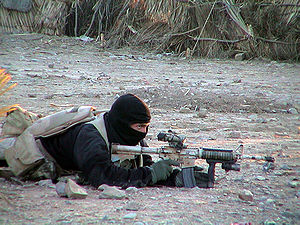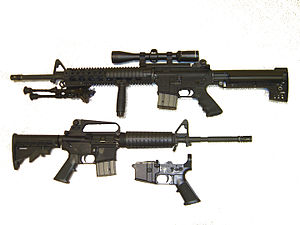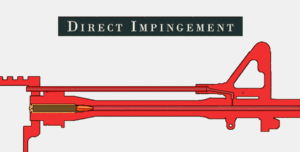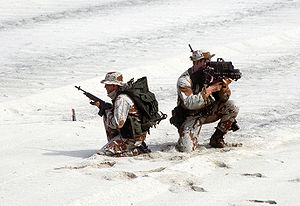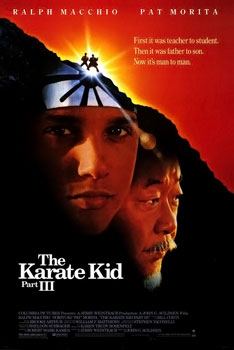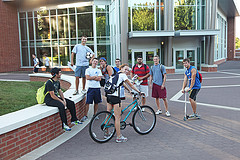
Image by York College of PA via Flickr
Even though I have a Navy SEAL as a husband, a Rottweiler as a personal bodyguard, and a fair amount of defensive firearms training, my parents still tell me to be safe every time I’m about to head out on a work trip. My parents know what I do for a living, but they are still my parents. They naturally will always worry that they haven’t told me everything and that I haven’t listened to what they’ve been telling me all these years. But, it makes them feel better to tell me to be safe, so I tell them I will. The benefit in my parents’ case is that I have been proactive to learn how to be safe past what they have known to tell me. This gives me a distinct advantage when I am out there alone, and I want to give this advantage to other people who go to school alone, travel alone or work alone.
Every single parent has these same worries when they leave their child alone for the first time on a college campus. To address this concern and in honor of National Campus Safety & Awareness month coming up in September, I wanted to write a blog to help parents who are sending their children off to college for the first time and who already have their children on a campus: 17 million young adults nationwide.
I’ll never forget the day that my parents dropped me off at Georgetown. I’ll never forget it because front page on the Georgetown University paper was a story about a young nursing student who had been found dead in the woods near the university. My mother saw the title and immediately wondered what she may have forgotten to tell me about safety that she could squeeze in to our last few minutes together. I’m sure she left with a nervous knot in her stomach rather than a relaxed feeling of ease that she had prepared me with the very best knowledge.
Most parents do not like to think that the unexpected might occur at college - their child being hurt, assaulted, raped, mugged or attacked. But the unfortunate reality of the college campus is that it is not as secure as many parents believe.
While most university rules require all dorm room doors to be locked and non-residents of a dorm to sign in when entering campus buildings, there are always loopholes. In fact, the most recent statistics show that there are more than 35,000 crimes on U.S. college campuses in one year.
SO, WHAT CAN YOU AS A LOVING PARENT DO TO BEST PREPARE YOUR SON OR DAUGHTER?
Here are my top 10 points of learning for parents to help prepare their children for the ultimate college experience: a safe one.
The first 5 points will be covered this week and the next 5 points will be covered next week, so stay tuned!
(1) Enroll your daughter or son in a DEFENSIVE FLASHLIGHT CLASS: Why a Defensive Flashlight class rather than mace, pepper spray or a rape defense class?
We as human beings are limited, which means we need tools to help us stay safe. But, we need tried and true tools that work with our lifestyles, not aggressive tools that do not fit who we are as students. A defensive flashlight (NOT from Costco!) is the best tool my Navy SEAL husband and I have found to stay safe for those individuals who do not feel comfortable carrying a handgun, but want more distance and security than mace/pepper spray provides.
A flashlight is easy to learn and use, no matter what age or physical size.
A flashlight can be carried on a plane, train or anywhere in the U.S.
There is no prior self-defense training needed to be effective.
It creates distance better than pepper spray and mace.
You can momentarily blind, distract and confuse from a distance.
NO legal repercussions for its use!
If you would like to know what flashlight I carry, call me at: 619.302.0262 and I can tell you what I’ve found to be the best of the best and why.
(2) Explain TRANSITION AREAS to your daughter or son and why these are the areas where they need to be more aware.
Transition areas are areas in between safe locations where your risk is higher, for example the area between your office and your parked car (the parking lot), the area between your class and your dorm (side streets), or the area between the mall and your parked car. In these situations the only priority should be personal safety, so no talking on the cell phones, no texting friends, no earphones with music.
(3) Teach them how to SEE A THREAT FROM A DISTANCE
The only way to tell from a distance if someone is a threat is to figure out ahead of time if a person has the capability to do you harm and the intent to do you harm. But how do you recognize this in others? Sealed Mindset has a list of more than 20 different criteria within our “15 Seconds to Safety” online program to recognize capability and intent from a distance, but the two best ones I use every day are to look at someone’s hands (window to capability) and their eyes (windows to intent). If someone’s hands are large, calloused, scarred, holding something and/or hidden from view, that allows me to notice possible capability. If someone’s eyes are shifting away from mine or shifting away when a person of authority walks into a room, that allows me to notice possible intent. If you have both at work, you can see a threat.
(4) Teach your son and daughter how to SEE DANGER AT NIGHT when they walk back to their dorm rooms.
What this means is that your child should learn how to use his or her natural night vision (and some other night vision skills too!) to reduce risk when moving from a well-lit area to a darker area and visa versa. I have used these easy night vision skills at least once every day since I learned them 7 years ago. I use one of the skills each evening when I leave my office to walk to my car. Before I leave the office, I turn out the lights in the hallway and I let my eyes adjust to the dark for 5 minutes before walking out into the night to get to my car. I do this because I want the added advantage of seeing better in the dark (when your eyes adjust) so that I will be more likely to notice something lurking in any shadows than if I had not taken those important five minutes to let my eyes adjust.
These night vision skills are the single most important skills young adults can learn to stay safe after they learn how to use a defensive flashlight. Lesson 6 in our 15 Seconds to Safety online course teaches this, so check it out:
http://www.sealedmindset.com/awareness-training/online-course
(5) Teach your son or daughter the 7 aspects of normal life that limit their security and then help them learn how to BREAK BAD HABITS so that they can limit their risk when they are alone.
Learning how to break myself of the 7 aspects of normal life (what we refer to as “social conditioning” at Sealed Mindset) that negatively impact my ability to stay safe, has changed my life more than anything else I have ever learned from my Navy SEAL husband. The first one I will mention here, but if you would like to know the other 6, shoot me an email and I will share them with you: anne@sealedmindset.com.
1 – How We Think About Our Environments
We limit ourselves in how we look at environments, everything from a coffee shop to a gym to an office space. We see signs that say “Employees Only” and tell ourselves we cannot go into those areas. Rather than seeing signs and reiterating the negative limitations that those signs impose on us, look at signs and think, “If something bad happened right now, where could I go to stay safe? What could I use to give me an advantage?” I always look at “Employee Only” signs as guidance rather than the rule, because if I can use those to my advantage to stay safe, I will.
When you enter a new place, look for the entry and exits, look for the safest place to sit, look for what you can use to create a barrier between yourself and someone else so that you have avenues of escape wherever you are. This is not paranoia; this is prior planning, and it makes you SMART. If you are a college student who knows this, it gives you the ultimate safety edge.
In my mind, 2 hours of online prevention to reduce the risk for a young adult is a small price to pay for peace of mind and to quiet those nervous knots. If my mother could have given me that gift when she dropped me off at Georgetown, she would have without hesitation. What are you waiting for? Now’s the time!
ADDED BONUS: For any young adult who takes our online course, we give him or her the direct number to SEALED MINDSET so that they have a Navy SEAL on their speed dial for any safety questions they might have when they are away from home – how many kids can say that these days?
Those are the first five techniques, but the best five are to follow in NEXT week’s blog! Make sure you check it out on Friday, August 19th. For more information on Sealed Mindset’s pre-college safety training, please email me: anne@sealedmindset.com.
FAMILY COLLEGE SAFETY RESOURCES
Security On Campus (Non Profit) Information on Sexual Assault, Homicide, Assault, Robbery, Weapons Violations, Threat/Alerts, and Other Crime on College Campuses:
http://www.securityoncampus.org/index.php?option=com_content&view=article&id=89&Itemid=63
Campus Safety Magazine:
http://www.campussafetymagazine.com/Channel/University-Security/Articles/2011/04/Clery-Reporting-Whose-Job-Is-It-Anyway.aspx
NEWS
Michigan Campus Attacks:
http://articles.cnn.com/2011-07-29/justice/michigan.fbi.probe_1_michigan-campus-attacks-composite-sketch?_s=PM:CRIME
ABC Primetime Special: http://abcnews.go.com/Primetime/story?id=1319608

